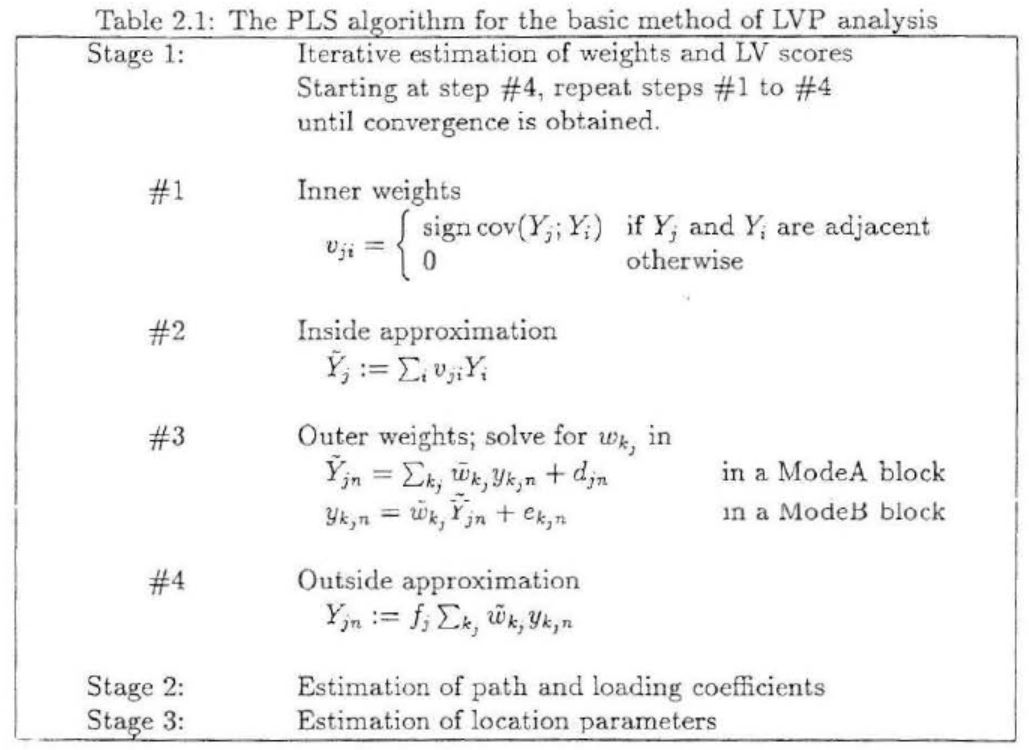PLS-SEM Algorithm
Abstract
The partial least squares (PLS) path modeling method, also called PLS structural equation modeling (PLS-SEM), was developed by Wold (1982) and further improved by Lohmöller (1989). In essence, the PLS-SEM algorithm is a sequence of regressions in terms of weight vectors. The weight vectors obtained at convergence satisfy fixed point equations.
Description
The PLS path modeling method was developed by Wold (1992) and the PLS algorithm is essentially a sequence of regressions in terms of weight vectors (Henseler et al., 2009). The weight vectors obtained at convergence satisfy fixed point equations (see Dijkstra, 2010, for a general analysis of such equations and ensuing convergence issues). The basic PLS algorithm, as suggested by Lohmöller (1989) and as implemented in SmartPLS, includes the following three stages:
Stage 1: Iterative estimation of latent variable scores consists of a 4-steps iterative procedure, which is repeated until convergence has been obtained (or the maximum number of iterations has been reached):
(1) outer approximation of the latent variable scores,
(2) estimation of the inner weights,
(3) inner approximation of the latent variable scores, and
(4) estimation of the outer weights.
Stage 2: Estimation of outer weights/loading and path coefficients.
Stage 3: Estimation of location parameters.
The following figure formally shows the Wold’s basic PLS-SEM algorithm as presented by Lohmöller (1989, p. 29):

Hair et al. (2022), Henseler et al. (2012), and Lohmöller (1989) provide detailed explanations on how the basic PLS-SEM algorithm operates as it is implemented in SmartPLS.
PLS Algorithm Settings in SmartPLS
Weighting Scheme
PLS-SEM allows the user to apply three structural model weighting schemes:
(1) factor weighting scheme,
(2) path weighting scheme (default), and
(3) principal component analysis (PCA).
While the results differ little for the factor and path weighting schemes, the path weighting is the recommended approach. This weighting scheme provides the highest R² value for endogenous latent variables and is generally applicable for all kinds of PLS path model specifications and estimations. In addition, researchers can choose the principle component analysis (PCA) option, which uses the results of a PCA per construct to estimate the model. Note: We do not further offer the centroid weighting scheme, which was available in SmartPLS 2 and 3.
Type of results
This option allows you to choose between
(1) standardized (default),
(2) unstandardized, and
(3) mean-centered
PLS-SEM outcomes. These settings affect the construct scores provided by the PLS-SEM algorithm and the estimated coefficients (e.g. standardized coefficients in structural model or unstandardized coefficients with intercept in the structural model).
Initial Outer Weights
- Standard: As the default (i.e., the SmartPLS settings), the initial outer weights are set to +1.
- Individual: SmartPLS to define individual initial outer weights for every indicator in the PLS path model. For example, are particularly important indicator can obtain a +1 (e.g., when the strong a positive relationship with the latent variable is assumed a prior), while the other indicators of the same measurement model obtain a 0.
Maximum Iterations
This option to change the settings for running the PLS-SEM algorithm is no longer available in SmartPLS 4. The permanent setting is 3,000 iterations. This parameter represents the maximum number of iterations that will be used for calculating the PLS results. This number should be sufficiently large (e.g., 3,000 iterations). When checking the PLS-SEM result, one must make sure that the algorithm did not stop because the maximum number of iterations was reached but due to the stop criterion. Note: The selection of 0 for the maximum number of iterations allows you to obtain results of the sum scores approach.
Stop Criterion
This option to change the settings for running the PLS-SEM algorithm is no longer available in SmartPLS 4. The permanent setting is 10^-7^. The PLS algorithm stops when the change in the outer weights between two consecutive iterations is smaller than this stop criterion value (or the maximum number of iterations is reached). This value should be sufficiently small (e.g., 10^-7^).
References
- Hair, J. F., Hult, G. T. M., Ringle, C. M., and Sarstedt, M. (2022). A Primer on Partial Least Squares Structural Equation Modeling (PLS-SEM), 3rd Ed., Sage: Thousand Oaks.
- Henseler, J., Ringle, C. M., and Sarstedt, M. (2012). Using Partial Least Squares Path Modeling in International Advertising Research: Basic Concepts and Recent Issues, in Handbook of Research in International Advertising, S. Okazaki (ed.), Edward Elgar Publishing: Cheltenham, pp. 252-276.
- Henseler, J., Ringle, C. M., and Sinkovics, R. R. (2009). The Use of Partial Least Squares Path Modeling in International Marketing, in Advances in International Marketing, R. R. Sinkovics and P. N. Ghauri (eds.), Emerald: Bingley, pp. 277-320.
- Lohmöller, J.-B. (1989). Latent Variable Path Modeling with Partial Least Squares, Physica: Heidelberg.
- Wold, H. (1982). Soft Modeling: The Basic Design and Some Extensions, in Systems Under Indirect Observations: Part II, K. G. Jöreskog and H. Wold (eds.), North-Holland: Amsterdam, pp. 1-54.
- More literature ...
Cite correctly
Please always cite the use of SmartPLS!
Ringle, Christian M., Wende, Sven, & Becker, Jan-Michael. (2024). SmartPLS 4. Bönningstedt: SmartPLS. Retrieved from https://www.smartpls.com

